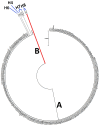Emergence of Rice Blast AVR-Pi9 Resistance Breaking Haplotypes in Yunnan Province, China
- PMID: 37374103
- PMCID: PMC10302552
- DOI: 10.3390/life13061320
Emergence of Rice Blast AVR-Pi9 Resistance Breaking Haplotypes in Yunnan Province, China
Abstract
The rice blast disease (caused by Magnaporthe oryzae) is a devastating disease in China. Understanding the molecular mechanisms of interaction for the cognate avirulence (AVR) gene with host resistance (R) genes, as well as their genetic evolution is essential for sustainable rice production. In the present study, we conducted a high-throughput nucleotide sequence polymorphism analysis of the AVR-Pi9 gene that was amplified from the rice-growing regions of the Yunnan Province in China. We detected the presence of seven novel haplotypes from 326 rice samples. In addition, the sequences of AVR-Pi9 were also obtained from two non-rice hosts, Eleusine coracana and Eleusine indica. The sequence analysis revealed the insertions and deletions in the coding and non-coding regions of the gene. The pathogenicity experiments of these haplotypes on previously characterized monogenic lines showed that the newly identified haplotypes are virulent in nature. The breakdown of resistance was attributed to the development of new haplotypes. Our results suggest that the mutation in the AVR-Pi9 gene is an alarming situation in the Yunnan province and thus needs attention.
Keywords: landrace; monogenic resistance; polymorphism; rice blast; virulence.
Conflict of interest statement
The authors declare no conflict of interest.
Figures




Similar articles
-
Novel haplotypes and networks of AVR-Pik alleles in Magnaporthe oryzae.BMC Plant Biol. 2019 May 16;19(1):204. doi: 10.1186/s12870-019-1817-8. BMC Plant Biol. 2019. PMID: 31096914 Free PMC article.
-
Loss and Natural Variations of Blast Fungal Avirulence Genes Breakdown Rice Resistance Genes in the Sichuan Basin of China.Front Plant Sci. 2022 Apr 12;13:788876. doi: 10.3389/fpls.2022.788876. eCollection 2022. Front Plant Sci. 2022. PMID: 35498644 Free PMC article.
-
Insertion of Transposable Elements in AVR-Pib of Magnaporthe oryzae Leading to LOSS of the Avirulent Function.Int J Mol Sci. 2023 Oct 24;24(21):15542. doi: 10.3390/ijms242115542. Int J Mol Sci. 2023. PMID: 37958524 Free PMC article.
-
Coevolutionary Dynamics of Rice Blast Resistance Gene Pi-ta and Magnaporthe oryzae Avirulence Gene AVR-Pita 1.Phytopathology. 2016 Jul;106(7):676-83. doi: 10.1094/PHYTO-02-16-0057-RVW. Epub 2016 May 13. Phytopathology. 2016. PMID: 27070427 Review.
-
Approaches to Reduce Rice Blast Disease Using Knowledge from Host Resistance and Pathogen Pathogenicity.Int J Mol Sci. 2023 Mar 5;24(5):4985. doi: 10.3390/ijms24054985. Int J Mol Sci. 2023. PMID: 36902415 Free PMC article. Review.
Cited by
-
The Role of Genetic Resistance in Rice Disease Management.Int J Mol Sci. 2025 Jan 23;26(3):956. doi: 10.3390/ijms26030956. Int J Mol Sci. 2025. PMID: 39940724 Free PMC article. Review.
-
The roles of Magnaporthe oryzae avirulence effectors involved in blast resistance/susceptibility.Front Plant Sci. 2024 Oct 9;15:1478159. doi: 10.3389/fpls.2024.1478159. eCollection 2024. Front Plant Sci. 2024. PMID: 39445147 Free PMC article. Review.
-
Status on Genetic Resistance to Rice Blast Disease in the Post-Genomic Era.Plants (Basel). 2025 Mar 5;14(5):807. doi: 10.3390/plants14050807. Plants (Basel). 2025. PMID: 40094775 Free PMC article. Review.
References
-
- Coelho M.A.D.O., Torres G.A.M., Cecon P.R., Santana F.M. Sowing Date Reduces the Incidence of Wheat Blast Disease. Pesqui. Agropecu. Bras. 2016;51:631–637. doi: 10.1590/S0100-204X2016000500025. - DOI
-
- Heath M.C., Valent B., Howard R.J., Chumley F.G. Interactions of Two Strains of Magnaporthe Grisea with Rice, Goosegrass, and Weeping Lovegrass. Can. J. Bot. 1990;68:1627–1637. doi: 10.1139/b90-209. - DOI
Grants and funding
- 31860481/National Natural Science Foundation of China
- 202102AE090003/Key Research and Development Program of Yunnan Province
- 202005AE160003/program of the Innovative Research Team of Yunnan Province
- 202105AG070001/Key Laboratory of Green Prevention and Control of Agricultural Transboundary Pests of Yunnan Province
LinkOut - more resources
Full Text Sources
Research Materials

